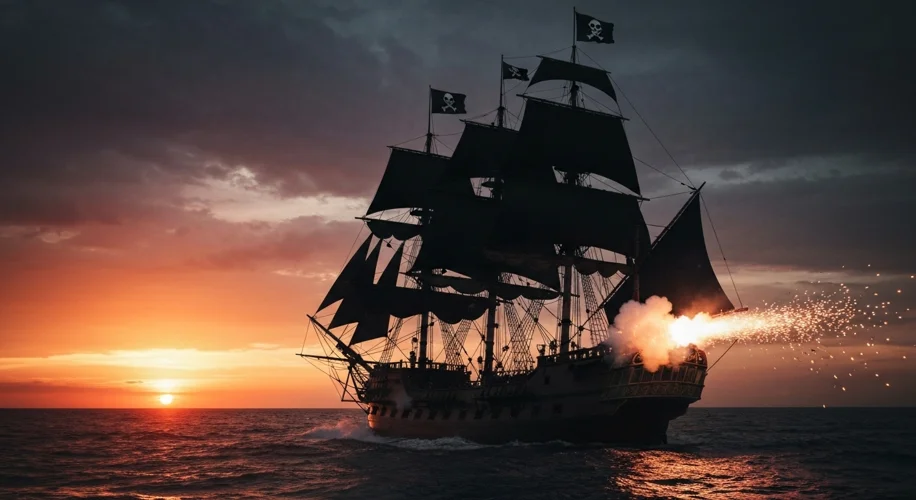The salt spray stings your eyes, the wind whips the tattered sails, and the distant cry of gulls is the only music you hear. For a fleeting, brutal period in the early 18th century, this was the reality for thousands of men who dared to defy the established order and carve out a life on the lawless waves. This was the Golden Age of Piracy, a time romanticized in tales of adventure, yet steeped in the grim realities of violence, disease, and short, often violent lives.
Imagine the Caribbean in the years following Queen Anne’s War (1701-1714). A generation of seasoned sailors, accustomed to the harsh discipline and brutal combat of naval warfare, found themselves adrift. With peace declared, many were discharged, their skills honed for destruction now rendered obsolete. For some, the lure of the sea and the promise of riches proved too strong to resist. They turned their swords and muskets not against foreign fleets, but against the very merchant ships they once protected.

This was the era of legendary figures who still capture our imagination. Edward Teach, better known as Blackbeard, was a master of psychological warfare. He cultivated a fearsome image, weaving burning fuses into his beard to appear demonic in the heat of battle. His ship, the Queen Anne’s Revenge, was a formidable sight, a floating terror that struck fear into the hearts of sailors from the Carolinas to the West Indies. His raids were audacious, his presence alone often enough to compel surrender.
Then there was Captain William Kidd. Unlike the archetypal brute, Kidd began his career as a respected privateer, commissioned to hunt pirates. However, his story took a darker turn, with accusations of turning pirate himself, blurring the lines between legitimate privateering and outright plunder. His capture and subsequent trial in London in 1701 became a sensational event, fueled by political intrigue and the public’s morbid fascination with his alleged treasures.
The romanticized image of the pirate—the swaggering captain with a parrot on his shoulder, buried treasure maps, and a code of honor among thieves—is largely a product of later fiction, most notably Sir Walter Scott’s Rob Roy and Edward Startling’s The Pirate. While the reality was far from these colorful portrayals, the core elements of rebellion and freedom resonated deeply.
But what was life really like for these men? The seas were a brutal mistress. Cramped living quarters, putrid food, and contaminated water were constants. Scurvy, a disease caused by vitamin C deficiency, was rampant, its victims suffering agonizing pain and often death. Discipline, while often less formal than on naval vessels, was still enforced, and mutiny or disobedience could lead to swift and severe punishment, often death.
The pirates’ “democracy” was a fragile thing. Captains were elected, and decisions were often made by a vote of the crew. Booty was divided according to a pre-arranged code, with captains and officers receiving larger shares, but every man who risked his life expected his due. This sense of shared enterprise, however, often dissolved in the face of overwhelming odds or betrayal.

The Golden Age was relatively short-lived. The sheer scale of piracy became an intolerable threat to lucrative colonial trade routes. Governments, particularly the British, began to crack down with a vengeance. Naval patrols increased, and draconian laws were enacted, making piracy punishable by death, often by hanging at the dockside as a public spectacle to deter others. Captain Kidd’s fate was a stark warning.
Figures like Woodes Rogers, a former privateer himself, were appointed governors of pirate havens like the Bahamas, offering pardons to those who surrendered while ruthlessly hunting down those who refused. Blackbeard himself met his end in a ferocious battle off the coast of North Carolina in 1718, his head later displayed on the bowsprit of a ship as a grim testament to the Crown’s resolve.
The fall of these pirate leaders marked the effective end of the Golden Age. While piracy never truly disappeared, it retreated from its audacious, widespread form. The romantic image, however, persisted, evolving into a powerful myth that continues to fascinate us. It speaks to a timeless desire for freedom, a rejection of authority, and the thrill of living on the edge, even if the “edge” was a brutal and unforgiving sea.
The allure of Blackbeard and Kidd lies not just in their daring raids, but in the stark contrast they represent: the dream of a life unbound versus the harsh, unforgiving reality of a world that ultimately reasserted its control. They were rebels, outlaws, and symbols of a brief, chaotic era when the sea belonged to no one, and fortunes—and lives—could be made or lost with the turn of a compass.

